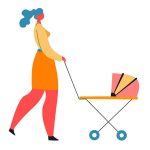1. Understanding Car Seat Types
Choosing the right car seat is one of the most important steps in keeping your child safe while traveling. There are three main types of car seats: rear-facing, forward-facing, and booster seats. The right choice depends on your childs age, weight, and height.
Rear-Facing Car Seats
Rear-facing car seats are designed for infants and young toddlers. Experts recommend keeping children in a rear-facing seat for as long as possible because it provides the best protection in case of an accident.
Types of Rear-Facing Seats:
- Infant Car Seats: Designed for newborns and smaller babies, these seats come with a detachable carrier that clicks into a base.
- Convertible Car Seats: Can be used in both rear-facing and forward-facing positions, allowing longer use as your child grows.
- All-in-One Car Seats: These can transition from rear-facing to forward-facing to a booster seat, making them a long-term option.
Forward-Facing Car Seats
Once your child outgrows their rear-facing seat, they should transition to a forward-facing seat with a harness. This type of seat helps distribute crash forces evenly across the strongest parts of their body.
Types of Forward-Facing Seats:
- Convertible Car Seats: Can switch from rear-facing to forward-facing with a harness.
- Combination Car Seats: Start as forward-facing seats with a harness but can later be converted into booster seats.
Booster Seats
A booster seat is used when your child has outgrown their forward-facing car seat but is still too small for a regular seat belt. Booster seats help position the vehicles seat belt properly across the childs chest and lap.
Types of Booster Seats:
- High-Back Booster Seats: Provide head and neck support, making them ideal for vehicles without headrests.
- Backless Booster Seats: Suitable for older kids who just need a little height boost to fit the vehicles seat belt properly.
Selecting the Right Car Seat
The best car seat for your child depends on their age, weight, and height. Use the following table as a general guideline:
| Car Seat Type | Recommended Age | Weight & Height Guidelines |
|---|---|---|
| Rear-Facing | Birth – 2+ years (as long as possible) | Follow manufacturer’s limits (usually up to 40 lbs) |
| Forward-Facing | Around 2 – 5 years | Typically 20–65 lbs (check specific car seat limits) |
| Booster Seat | Around 5 – 12 years | Mature enough to sit properly; usually 40–100+ lbs |
| No Car Seat (Seat Belt Only) | Around 8 – 12+ years | Must pass the “seat belt fit” test; typically at least 49″ tall |
Selecting the right car seat ensures your child is as safe as possible while on the road. Always check the manufacturers guidelines and follow local car seat laws to ensure compliance with safety standards.
2. Proper Installation Techniques
Ensuring your childs car seat is installed correctly is crucial for their safety. Whether youre using the LATCH system or a seat belt, following the proper steps can prevent serious injuries in case of an accident. Here’s what you need to know about installing a car seat the right way.
Using the LATCH System
The Lower Anchors and Tethers for Children (LATCH) system is designed to make car seat installation easier without using a seat belt. Most vehicles manufactured after 2002 come equipped with LATCH anchors.
Steps to Install Using LATCH
- Locate the lower anchors in your vehicles back seat.
- Attach the car seat’s lower anchor connectors to the anchors.
- Pull the straps tight to remove any slack.
- If forward-facing, connect and tighten the top tether strap.
- Check that the car seat does not move more than one inch side-to-side or front-to-back.
Installing with a Seat Belt
If your car does not have LATCH or if your child has exceeded the LATCH weight limit, you can use the vehicles seat belt instead.
Steps to Install Using a Seat Belt
- Thread the seat belt through the correct path on the car seat (rear-facing or forward-facing).
- Buckle the seat belt and pull it tight.
- If required, engage the seat belt’s locking mechanism by pulling it all the way out and then letting it retract.
- If forward-facing, attach and tighten the top tether strap.
- Check that there is no more than one inch of movement in any direction.
Avoiding Common Installation Mistakes
| Mistake | How to Fix It |
|---|---|
| The car seat moves too much | Tighten straps or use a rolled towel to adjust positioning. |
| The recline angle is incorrect | Use built-in level indicators or adjust according to manufacturer instructions. |
| The seat belt isn’t locked | Ensure its fully pulled out and retracted to activate locking mode. |
| The harness is too loose | Tighten until you cant pinch excess strap material at the shoulders. |
| The top tether isn’t used (for forward-facing seats) | Always attach and tighten it to reduce head movement during a crash. |

3. Harnessing Your Child Safely
Making sure your baby is securely fastened in their car seat is one of the most important steps in car seat safety. A properly adjusted harness keeps your little one safe by preventing excessive movement in case of sudden stops or crashes.
How to Buckle Your Baby Correctly
Follow these steps to ensure your child is securely harnessed every time:
- Place your baby in the seat: Make sure their back is flat against the car seat with no slouching.
- Position the straps correctly: For rear-facing seats, shoulder straps should be at or below your baby’s shoulders. For forward-facing seats, they should be at or just above the shoulders.
- Buckle and tighten: Secure the harness buckle and chest clip, then pull the strap to remove any slack.
- Check tightness: Perform the “pinch test” – if you can pinch any excess strap at the shoulders, it needs to be tightened more.
The Importance of Proper Strap Positioning
The way you position the harness straps plays a crucial role in protecting your child. Here’s a simple guide to proper positioning:
| Car Seat Position | Correct Shoulder Strap Placement |
|---|---|
| Rear-Facing | At or below shoulder level |
| Forward-Facing | At or above shoulder level |
Tightening the Harness Properly
A loose harness can put your child at risk during an accident. Use these tips to ensure a snug fit:
- The Pinch Test: Try pinching the harness strap at your child’s shoulders. If you can grab any extra fabric, it’s too loose.
- No Bulky Clothing: Avoid dressing your child in thick coats or padded outfits that can create slack in the harness.
- Smooth Out Twists: Make sure the straps lie flat against your child’s body without twisting.
A Quick Safety Checklist
Before starting your drive, go through this quick checklist:
- The harness is snug and passes the pinch test.
- The chest clip is positioned at armpit level.
- The straps are flat and not twisted.
- Your child is dressed in lightweight clothing for a secure fit.
Taking a few extra seconds to properly buckle and adjust your childs harness can make all the difference in keeping them safe on the road.
4. Common Car Seat Mistakes to Avoid
Using a car seat correctly is crucial for your childs safety, but many parents unknowingly make mistakes. Here are some of the most common car seat misuse issues and how to prevent them.
Loose Harness Straps
A loose harness can put your child at risk during an accident. The straps should be snug, with no extra slack. Use the “pinch test”—if you can pinch any fabric between your fingers at the shoulders, the straps need to be tightened.
Incorrect Recline Angle
Newborns and infants need a specific recline angle to keep their airways open. Most car seats have built-in angle indicators or adjusters. Always check your manual to ensure youre using the correct setting for your childs age and weight.
Expired or Recalled Car Seats
Car seats have expiration dates due to material wear and evolving safety standards. Check the label on your car seat for its expiration date, and always register your car seat to receive recall notifications.
Common Car Seat Mistakes and How to Fix Them
| Mistake | Why Its Dangerous | How to Fix It |
|---|---|---|
| Loose harness straps | The child may be ejected in a crash | Tighten straps until snug; use the pinch test |
| Incorrect recline angle | Poor positioning can restrict breathing | Check recline indicator; adjust as needed |
| Expired car seat | Materials degrade over time, reducing effectiveness | Check the expiration date; replace if needed |
| Buckling over thick clothing | Puffy coats create false security, leading to loose harness fit | Dress child in thin layers; use a blanket over harness if needed |
| Not securing the car seat properly | An improperly installed seat wont protect in a crash | Follow manufacturer instructions; use LATCH system or seat belt correctly |
Avoiding These Mistakes for Safer Travel
The best way to ensure your childs safety is by carefully following car seat guidelines and regularly checking for errors. Take time to read your car seats manual, watch installation videos from reputable sources, and seek professional help if needed. Many local fire stations and child safety organizations offer free car seat checks.
5. When to Transition to the Next Stage
Knowing when to move your child from one car seat stage to the next is crucial for their safety. The transition should always be based on your childs height, weight, and developmental readiness, as well as state laws and safety recommendations.
Rear-Facing to Forward-Facing
Pediatricians and safety experts recommend keeping your child in a rear-facing car seat for as long as possible, typically until at least age 2 or when they outgrow the seat’s height and weight limits set by the manufacturer.
Signs Its Time to Transition:
- Your child exceeds the rear-facing weight or height limit of their car seat.
- Their head is less than an inch from the top of the seat when seated.
- Your childs legs may appear cramped, but this is not a reason to switch too early—rear-facing remains safest.
Forward-Facing to Booster Seat
Once your child has outgrown the forward-facing car seat with a harness (usually around 40-65 lbs), they can move to a booster seat. However, they should remain in a forward-facing seat as long as possible before making the switch.
Signs Your Child Is Ready for a Booster Seat:
- Your child surpasses the weight or height limits of their forward-facing car seat.
- They can sit properly without slouching and keep the seatbelt positioned correctly across their chest and lap.
- Their shoulders are above the highest harness slot in their current car seat.
Booster Seat to Seat Belt
A booster seat helps position your child so that the vehicle’s seat belt fits them properly. Most children need a booster until they are at least 4 feet 9 inches tall, which usually happens between ages 8-12.
The Five-Step Seat Belt Test:
| Step | Description |
|---|---|
| 1 | Your child sits all the way back against the cars seat. |
| 2 | Their knees bend naturally at the edge of the seat. |
| 3 | The lap belt lies snugly across their upper thighs, not their stomach. |
| 4 | The shoulder belt rests across their chest and shoulder, not their neck or face. |
| 5 | Your child can sit properly without slouching or moving out of position. |
If they do not pass all five steps, they should continue using a booster seat for optimal protection.


